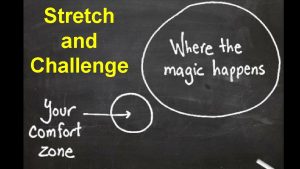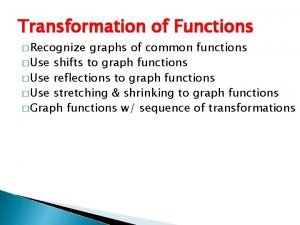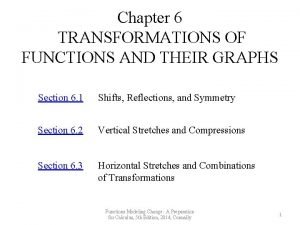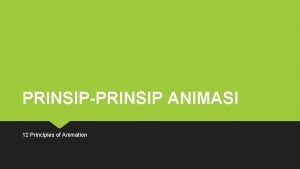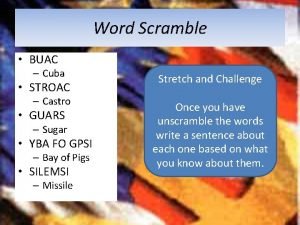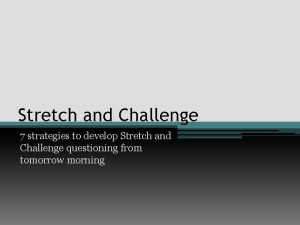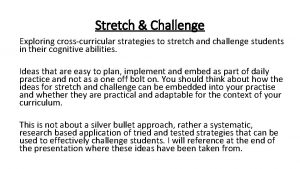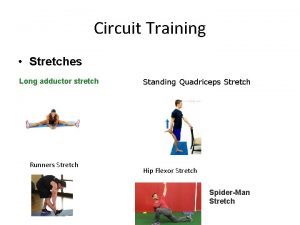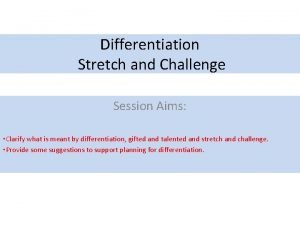Stretch and Challenge What is stretch and challenge









- Slides: 9

Stretch and Challenge

What is stretch and challenge and what is it not? It is not just for the ‘gifted and talented’ It does not ignore differentiation, but differentiation is designed to help students access materials to participate in higher-order thinking – there is no glass ceiling! It is not a ‘quick fix’ – it needs to be thought about carefully throughout all lessons, it involves the culture of the classroom and the school as well as the activities It is not easy – students should realise and take pride in the fact that real learning is hard work and will require lots of practice

What should Stretch and Challenge include? Challenge! • Genuine challenge in terms of student thinking. Taxonomies such as Bloom’s or SOLO could be helpful in planning for this. • Tasks which require multiple levels of thinking and encourage students to make links between areas of learning (and subjects – very MYP!)

What should Stretch and Challenge include? Metacognition Giving students the opportunities to reflect on how they learn and how they can find things out for themselves. Giving students the vocabulary and discussion time to reflect on and discuss their learning. DIRT (Dedicated Improvement and Reflection Time) – including extending learning.

What should Stretch and Challenge include? Questioning Avoid time to ‘sit back’ – team questioning and team discussion before answers could help, as could ‘bouncing’ the question to get students to add to quality of answers. Refuse to accept answers until they have been ‘polished’ i. e. using academic language, key terms, providing examples etc. Open rather than closed questions are most beneficial. ‘Thunks’ e. g. ‘What colour is Monday? ’ or counterfactuals ‘What if Hitler had never been born? ’ Students should also form their own questions to answer.

What should Stretch and Challenge include? Vocabulary building Students need high levels of literacy to access the curriculum and academic excellence Vocabulary should include subject specific terms e. g. lateral moraine, differential, oligarchy It should also include vocabulary to enable them to access questions e. g. analyse, discuss, evaluate Word banks, glossaries, use of thesaurus all good techniques; ‘posh up’ writing – challenge students to start simple and then make it as academic and formal as possible; give opportunities to correct spellings and choose alternative words

What should Stretch and Challenge include? Independence Students must be responsible for their own learning – to find things out, to put extra effort in Spoon feeding, or ‘sitting back’ has to be challenged and lessons should be planned to avoid any opportunity Group work, different roles, team competition, rewards for effort or going the extra mile Resilience Students must be taught to draft and re-draft work until it is the best it can be Teachers should not accept anything less than a student’s best Praise should be directed towards trying, experimenting, taking time, working hard etc. not ‘natural ability’ or easy praise ‘well done, you’ve underlined it with a ruler!’

Websites used for images and research http: //www. sec-ed. co. uk/best-practice/stretch-and-challenge-in-your-classroom/ http: //www. johnbiggs. com. au/academic/solo-taxonomy/ http: //www. lovelearningideas. com/stretch-challenge/ http: //www. queensu. ca/teachingandlearning/modules/students/24_metacognition. html https: //slideplayer. com/slide/10419363/ https: //www. theflippedclassroom. es/pbl-cbl-dbl-todo-tiene-que-ver-con-el-aprendizaje/

Further reading Robin Alexander, Towards Dialogic Teaching, (5 th Edition, 2017, ISBN 978 -0954694371) Michael Gershon, How to use Bloom’s Taxonomy in the Classroom, (2015, 978 -1517432010) Hodgkinson and Mercer (Eds. ), Exploring Talk in School: Inspired by the work of Douglas Barnes, (2008, ISBN 978 -1847873798) Debbie Light, Bloomsbury CPD Library: Stretch and Challenge (2017, 978 -1472928405) Marzano and Pickering, Building Academic Vocabulary (2005, ISBN 978 -1416602347) Torsten Payne, Stretch and Challenge for All: Practical Resources for Getting the Best out of every student (2017, 978 -1785831591)
